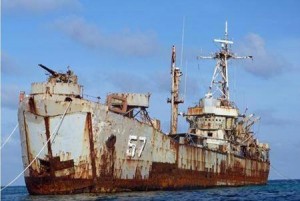We treasure our Sierra Madre
In the1948 John Houston movie, “The Treasure of the Sierra Madre,” three destitute Americans working as gold prospectors mining the Sierra Madre mountains in Mexico are confronted by bandits posing as mounted police (“Federales”). When they are asked to produce their badges, the chief bandit’s response is classic:
“Badges? We don’t need no stinking badges!”
When China is asked to prove its ownership of all of the South China Sea, all 1.7 million square miles of it, including all of the islands and outcrops within the 200 mile exclusive economic zone (EEZ) of the Philippines, we can imagine China’s response:
“Proof? We don’t need no stinking proof?”
That may be a better response than the “stinking proof” China actually presented to the United Nations on May 7, 2009, when it presented a map of the South China Sea drawn by the Kuomintang government on December 1, 1947. Originally an 11-line map, it was later reduced to 9 lines by the Chinese Communists in 1949 and then recently increased to 10 in 2013.
China’s multi-line map does not contain any specific geographic coordinates and does not explain how it would be connected if it were a continuous line. Prof. Yin Wenqiang, a senior Chinese government maritime law expert, candidly admitted in a US Embassy cable in 2008 that he was unaware of the historical basis for China’s claim.

This spurious claim was the basis for China’s illegal 1995 occupation of Mischief Reef (Panganiban Reef), just 130 miles from Palawan. China has constructed a four-story Chinese military garrison with a helipad on the outcropping shoal of Mischief Reef.
China has also planted buoys in Sabina Shoal, which is just 70 miles from Palawan. It is China’s “well-rehearsed routine” when laying claim to a shoal to first put down buoys, then place concrete markers, then build temporary wooden or bamboo shelters, and if unchallenged, to then erect permanent military installations.
Recognizing that China was seeking to occupy the Ayungin Shoal, which is only 13 nautical miles from Mischief Reef and just 108 nautical miles from Palawan, the Philippine Navy deployed its mothballed ship, the BRP Sierra Madre (originally built as a tank-loading US warship in 1944), to the Ayungin Shoal and then deliberately ran it aground to serve as a marine outpost to guard the uninhabitable Ayungin Shoal. Ayungin’s real value is its strategic proximity to the oil-rich Recto Bank.
There was little action in the Ayungin Shoal from 1999 until May of 2013, when three Chinese ships appeared on the shoal’s horizon to signal the beginning of China’s naval blockade of the shoal. Philippine Defense Secretary Voltaire Gazmin assured the Filipino people at the time that the Philippine Navy would defend Ayungin “to the last soldier standing.”
China’s Major General Zhang Zhaozhong previously explained China’s “cabbage strategy” to occupy Ayungin Shoal, the same strategy successfully employed in securing Mischief Reef and the Scarborough Shoal.
“In the area around the island, fishing administration ships and marine surveillance ships are conducting normal patrols while in the outer ring there are navy warships. The island is thus wrapped layer by layer like a cabbage. As a result, a cabbage strategy has taken shape. If the Philippines wants to go in, in the outermost area, it has first to ask whether our navy will allow it. Then it has to ask whether our fishery administration ships and marine surveillance ships will allow it.”
“For those small islands, only a few troopers are able to station on each of them, but there is no food or even drinking water there. If we carry out the ‘cabbage’ strategy, you will not be able to send food and drinking water onto the islands,” Zhang said. The Filipino troops stationed there would be forced to leave and China could then occupy the territory without firing a shot.

But the Chinese ships returned back to Ayungin Shoal in early 2014, and when two Philippine vessels arrived in the Shoal with fresh marines to replace those who were stationed there in November of 2013, the Chinese ships barred them from reaching the Sierra Madre on March 9.
Undeterred, on March 28, the Philippine Navy deployed another civilian vessel (AM 700) on a 30-hour voyage from Palawan to the Sierra Madre filled with marine replacements, 10 tons of food and water supplies and a dozen representatives of the foreign and local media.
As their vessel neared the Sierra Madre, two Chinese coast guard ships appeared in front of them to block them. A Chinese coast guard ship marked “1141″ crossed the bow of the smaller Philippine vessel to stop it from proceeding forward. Another tailed the Filipino boat.
The Chinese radioed the Filipinos, telling them to stop. “You will take full responsibility for the consequences of your action,” the voice said in English.
“This is the Republic of the Philippines,” Philippine Navy Lt. Ferdinand Gato, who was in charge of the supply mission, replied. “We are here to provision the troops.”

“Chinese coast guards are now harassing us. They are blowing their horns, ordering us out of the area, saying we are conducting an illegal operation,’’ Dizon reported.
But the Philippine boat successfully maneuvered through a shallow approach to the shoal where the larger Chinese ships could not follow and successfully docked alongside the Sierra Madre.

The fresh crew of Philippine marines and the members of the media boarded the Sierra Madre and watched as the marines who had been stationed for four months on the ship dressed in their military fatigues, with their scraggly beards, proudly raised the Philippine flag in a “relieving the watch” ceremony. The photo of this ceremony went viral and may yet be the iconic photo of the “Battle of Ayungin”.
At virtually the same time that the flag was being raised on the Sierra Madre, the Philippine government was submitting its memorandum to the Arbitral Tribunal of the United Nations Convention on the Law of the Sea (UNCLOS) at The Hague in the Netherlands challenging China’s territorial claims over the West Philippine Sea (South China Sea).

For now, the Philippine flag still flies over the Sierra Madre with its contingent of fresh Philippine marines to protect the Ayungin Shoal from a hegemonist China fully determined to seize it.
Will China wait until the term of office of President Aquino ends in June 2016 and a new president more supportive of China’s claims is elected? China does not actually need to pour billions of pesos into the coffers of its preferred presidential candidate; it can simply ask the Chinese Filipino Taipans – with enormous investments in China — to financially back a more pro-China candidate, someone more like former Pres. Gloria Macapagal-Arroyo.
Or will China be unwilling to wait that long and just increase the number of its ships surrounding the Ayungin Shoal to prevent the next Philippine resupply ship from slipping through?
In the meantime, a group of US Pinoys in San Francisco is asking the Philippine Navy to set up a special fund to raise the money needed to paint the dilapidated and crumbling Sierra Madre ship, perhaps with bright Philippine flag colors of blue, white and red.
“That way, every time the Chinese invaders see our Sierra Madre, they will know without doubt who owns the Ayungin Shoal,” said Esther Aure Asercion, one of the project’s organizers.
(Send comments to Rodel50@gmail.com or mail them to the Law Offices of Rodel Rodis at 2429 Ocean Avenue, San Francisco, CA 94127 or call 415.334.7800).
RELATED STORIES
What did Estrada and Arroyo promise China?
For comprehensive coverage, in-depth analysis, visit our special page for West Philippine Sea updates. Stay informed with articles, videos, and expert opinions.

